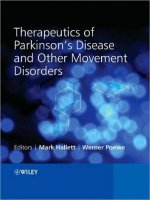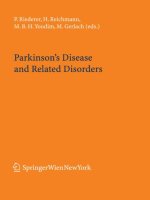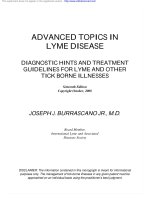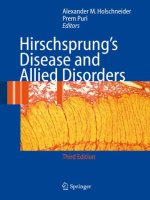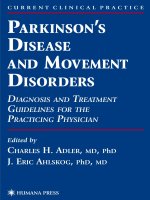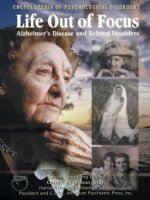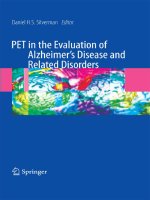PARKINSON''''S DISEASE AND MOVEMENT DISORDERS: DIAGNOSIS AND TREATMENT GUIDELINES FOR THE PRACTICING PHYSICIAN potx
Bạn đang xem bản rút gọn của tài liệu. Xem và tải ngay bản đầy đủ của tài liệu tại đây (3.73 MB, 490 trang )
C U R R E N T C L I N I C A L P R A C T I C E
P
ARKINSON
’
S
D
ISEASE
AND
M
OVEMENT
D
ISORDERS
Edited by
CHARLES H. ADLER, MD, PhD
J. ERIC AHLSKOG, PhD, MD
HUMANA PRESS
D
IAGNOSIS
AND
T
REATMENT
G
UIDELINES
FOR
THE
P
RACTICING
P
HYSICIAN
PARKINSON'S DISEASE AND MOVEMENT DISORDERS:
D
IAGNOSIS AND TREATMENT GUIDELINES FOR THE PRACTICING PHYSICIAN
C
URRENT
9
C
LINICAL
9
P
RACTICE
Parkinson’s Disease and Movement Disorders:
Diagnosis and Treatment Guidelines for the Practicing Physician,
edited by CHARLES H. ADLER AND J. ERIC AHLSKOG, 2000
Bone Densitometry in Clinical Practice:
Application and Interpretation, by S
YDNEY LOU BONNICK, 1998
Diseases of the Liver and Bile Ducts: Diagnosis and Treatment,
edited by GEORGE Y. WU AND JONATHAN ISRAEL, 1998
The Pain Management Handbook: A Concise Guide
to Diagnosis and Treatment, edited by M. E
RIC GERSHWIN
AND
MAURICE E. HAMILTON, 1998
Sleep Disorders: Diagnosis and Treatment, edited by J. S
TEVEN POCETA
AND
MERRILL M. MITLER, 1998
Allergic Diseases: Diagnosis and Treatment,
edited by P
HIL LIEBERMAN AND JOHN A. ANDERSON, 1997
Osteoporosis: Diagnostic and Therapeutic Principles,
edited by C
LIFFORD J. ROSEN, 1996
PARKINSON'S DISEASEAND
MOVEMENT DISORDERS
D
IAGNOSIS AND
T
REATMENT
G
UIDELINES
FOR THE
P
RACTICING
P
HYSICIAN
HUMANA PRESS
TOTOWA, NEW JERSEY
Edited by
CHARLES H. ADLER, MD, PHD
Consultant and Co-Director, Parkinson’s Disease and Movement
Disorders Center, Department of Neurology, Mayo Clinic Scottsdale,
Scottsdale, AZ; Associate Professor of Neurology, Mayo Medical
School, Rochester, MN
and
J. ERIC AHLSKOG, PHD, MD
Chair, Division of Movement Disorders, and Consultant,
Department of Neurology, Mayo Clinic Rochester, Rochester, MN;
Professor of Neurology, Mayo Medical School, Rochester, MN
Copyright © 2000 Mayo Foundation for Medical Education and Research.
For additional copies, pricing for bulk purchases, and/or information about other Humana titles,
contact Humana at the above address or at any of the following numbers: Tel: 973-256-1699;
Fax: 973-256-8341; E-mail: or visit our website at
All rights reserved. This book is protected by copyright. No part of it may be reproduced, stored in a retrieval
system, or transmitted in any form or by any means, electronic, mechanical, photocopying, recording, or otherwise,
without written permission from the Mayo Foundation.
As new scientific information becomes available through basic and clinical research, recommended treatments and drug
therapies undergo changes. The authors and publisher have made all reasonable attempts to make this book accurate,
up to date, and in accord with accepted standards at the time of publication. The authors, editors, and publisher are not
responsible for errors or omissions or for consequences from application of the book, and make no warranty, expressed
or implied, in regard to the contents of the book. Any practice described in this book should be applied by the reader
in consultation with a physician and taking regard of the unique circumstances that may apply in each situation. The
reader is advised always to check product information (package inserts) for changes and new information regarding
dose and contraindications before administering any drug. Caution is especially urged when using new or infrequently
ordered drugs. Nothing in this publication implies that Mayo Clinic endorses the products or equipment mentioned in
this book.
All articles, comments, opinions, conclusions, or recommendations are those of the author(s) and do not necessarily reflect
the views of the publisher or of Mayo Clinic.
This publication is printed on acid-free paper. '
ANSI Z39.48-1984 (American National Standards Institute)
Permanence of Paper for Printed Library Materials.
Photocopy Authorization Policy:
Authorization to photocopy items for internal or personal use, or the internal or personal use of specific clients, is granted
by Humana Press Inc., provided that the base fee of US $10.00 per copy, plus US $00.25 per page, is paid directly to
the Copyright Clearance Center at 222 Rosewood Drive, Danvers, MA 01923. For those organizations that have been
granted a photocopy license from the CCC, a separate system of payment has been arranged and is acceptable to Humana
Press Inc. The fee code for users of the Transactional Reporting Service is: [0-89603-406-2/98 $10.00 + $00.25].
Printed in the United States of America. 10 9 8 7 6 5 4 3 2 1
PREFACE
v
The field of movement disorders is relatively broad, encompassing disorders of in-
creased movement, such as tremors, dystonia, and tics, to disorders characterized by a
paucity of movement, such as Parkinson’s disease. Our understanding of the pathogenic
mechanisms and our treatment options are expanding at a rapid pace. This expansion
ranges from the medical and surgical advances in treating Parkinson’s disease to the flood
of genetic abnormalities that have now been found to cause various movement disorders.
Although many patients are seen by the movement disorders specialist in neurology
clinics around the country, most of these patients receive their follow-up care from a
primary care physician or “general” neurologist who must be versed in the characteristics
and treatment plans of this diverse group of disorders.
The major goal of Parkinson’s Disease and Movement Disorders: Diagnosis and
Treatment Guidelines for the Practicing Physician is to distill this immense amount of
information and to educate the practitioner about the many facets of the movement
disorders field. We believe that this book fills a large void, since most texts on movement
disorders are more detailed and geared toward the specialist. We have asked the chapter
authors to emphasize the clinical characteristics of each disorder, discuss the differential
diagnosis and the diagnostic testing, and then outline the various treatment options, as if
they were teaching during a preceptorship in their clinic. To this end, we have not de-
signed the book to be an exhaustive review of each topic; rather, it takes a general
approach to each subject. We have avoided referencing each statement; a short list of
further recommended reading sources is given at the end of each chapter.
The purpose of this text is to help the practitioner distinguish which disorder is being
encountered, give a basic understanding for test and treatment options that are required,
and synthesize any recommendations made by a consulting specialist. As the movement
disorders specialist becomes busier and insurance regulations limiting specialty referrals
increase, the burden of caring for these patients by the primary care physician will
continue to grow. Thus, we hope that this text will offer the reader full confidence in
approaching patients with movement disorders.
The text is organized into five sections: basic diagnostic principles, Parkinson’s dis-
ease, other parkinsonian disorders, hyperkinetic movement disorders, and other move-
ment disorders. In Chapter 1 of Section A: Basic Diagnostic Principles, Dr. J. Eric
Ahlskog provides an extensive overview on the neurologic examination. Since move-
ment disorders can involve all parts of the neurologic system, a detailed neurologic
examination is often imperative when these patients are evaluated. Changes in speech
often occur in many of the disorders, and the speech characteristics may provide impor-
tant diagnostic clues. In Chapter 2, Dr. Joseph Duffy describes the varieties of motor
speech abnormalities that may be encountered and provides a systematic approach to
their recognition.
Given the frequency of Parkinson’s disease (PD), the tremendous advances made over
the past two decades in understanding the disease and its treatment, and the debates on
the “best” way to treat the patient, we have devoted 12 chapters to this entity in Section
B: Parkinson’s Disease. In Chapter 3, Dr. Howard Hurtig discusses the pathophysiology,
neurochemistry, and neuropathology of PD. This is followed by Dr. Richard Dewey’s
description of the clinical characteristics of PD in Chapter 4, outlining not only the typical
features, such as rest tremor and slowness of movement, but also clinical signs suggesting
an atypical form of parkinsonism.
What causes PD? The intriguing search for etiologic answers has generated volumes
of studies and papers, sometimes with conflicting results. This information is distilled in
two chapters. The epidemiologic studies of PD, which have generated multiple clues to
the etiology, are reviewed by Dr. Demetrius Maraganore in Chapter 5. This chapter
covers reported risk factors and the role of genetics (including the defects in the _-
synuclein gene) in addition to basic incidence and prevalence data. On the other hand,
basic bench research has produced multiple lines of evidence for a variety of possible
causal factors. Etiologic hypotheses generated from knowledge of biochemical mecha-
nisms are comprehensively reviewed by Dr. Peter LeWitt in Chapter 6. This chapter
includes discussion of the roles of oxidative stress, mitochondrial dysfunction, and neu-
rotoxins and addresses etiologic mechanisms that have received less publicity, such as
possible autoimmune and infectious causes.
We have divided the discussion of the medical treatment of PD into three chapters. The
issue of whether our current drug arsenal includes medications that will slow the progres-
sion of PD is hotly debated, and in Chapter 7, Dr. Ahlskog tackles the theories and
practical issues for the practitioner. Chapter 8, also by Dr. Ahlskog, is devoted to the
various treatment options available for the patient with newly diagnosed PD. This in-
cludes decision-making regarding the use of levodopa, dopamine agonists, and numerous
other agents. The complicated issue of how to treat the patient with more advanced PD
is covered by Dr. Ryan Uitti in Chapter 9.
Patients with PD also have nonmotor manifestations that can be as disabling as the tremor
and bradykinesia. The sleep problems of PD, including insomnia and daytime drowsiness,
are addressed by Dr. Cynthia Comella in Chapter 10. Neurogenic bladder and bowel prob-
lems and symptomatic orthostatic hypotension are common issues in the PD clinic; these
autonomic problems and treatment strategies are covered by Dr. Bradley Hiner in Chapter 11.
Dementia, psychosis, and depression can be overwhelming factors in the patient with more
advanced PD, and Dr. Erwin Montgomery discusses these in Chapter 12.
Currently, the most visible topic concerning PD is surgical treatment, which has made
newspaper and television headlines for the past several years. In Chapter 13, Dr. Kathleen
Shannon discusses neurosurgical intervention, including pallidotomy, thalamotomy, deep
brain stimulation, and cerebral transplantation, and reviews the prospects for the future.
She provides guidelines on which patients may benefit and which of the different proce-
dures may be appropriate for a given patient.
Therapy for patients with PD does not end with medications and surgery; Chapter 14,
written by Drs. Padraig O’Suilleabhain and Susan Murphy, addresses adjunctive treat-
ments. They include nutrition and dietary issues, which are especially important in ad-
vancing disease. They also address the role of physical therapy in management of
parkinsonian motor problems.
All disorders characterized by slowness of movement are not PD, and in Section C we
have devoted six chapters to discussing these other disorders. In Chapter 15, Drs. Eric
Molho and Stewart Factor cover secondary causes of parkinsonism, such as vascular,
toxic, and traumatic etiologies; they also provide a practical strategy for the workup of
parkinsonism. Among the more common neurodegenerative disorders sometimes mis-
taken for PD is progressive supranuclear palsy; the key clinical signs and points that
vi Preface
separate this disorder from PD are covered by Dr. Mark Stacy in Chapter 16. When
patients have cerebellar signs, prominent autonomic dysfunction, or resistance to dopa-
minergic therapy, one must consider the multiple system atrophies discussed by Dr.
James Bower in Chapter 17. Inherited cerebellar disorders, including the autosomal
dominant spinocerebellar ataxias, sometimes resemble sporadic multiple system
atrophyand occasionally PD; these familial ataxic syndromes are reviewed by Dr. Bower
in Chapter 18. Corticobasal degeneration may resemble PD early in the course. The
clinical hallmarks that allow differentiation are covered by Dr. Brad Boeve in Chapter 19.
The final chapter in this section, Chapter 20, by Dr. Richard Caselli, describes the various
primary dementing disorders, including Alzheimer’s disease, that often include compo-
nents of parkinsonism.
Section D begins the discussion of disorders characterized by too much movement, or
hyperkinetic movement disorders. All the chapters in this section address the character-
istics of the individual disorders, diagnostic considerations, and treatment options. We
begin by a discussion of the most commonly encountered movement disorder, tremor.
Chapter 21, by Dr. Joseph Matsumoto, describes the different types of tremor and how
to differentiate and treat them. Chapter 22, by Dr. Jean Hubble, goes into further detail
about the most commonly seen tremor, essential tremor.
Dystonia is a more common disorder than is often appreciated, occurring in adulthood
as torticollis, blepharospasm, writer’s cramp, and other focal or segmental dystonias.
These along with generalized dystonic conditions, including primary torsion dystonia
developing in childhood, are reviewed by Dr. Daniel Tarsy in Chapter 23. Hemifacial
spasm is sometimes mistaken for facial dystonia; this disorder, due to compression of the
seventh cranial nerve, is discussed by Dr. Mark Lew in Chapter 24.
The dancing movements of chorea have origins ranging from inherited (Huntington’s
disease) to infectious (Sydenham’s chorea) causes. Clinical characterization and treat-
ment are covered by Dr. John Caviness in Chapter 25. Tardive dyskinesias are sometimes
confused with primary choreiform syndromes. These iatrogenically induced conditions
are discussed by Dr. Kapil Sethi in Chapter 26.
The lightning-like jerks of myoclonus occasionally cause diagnostic confusion; if
repetitive, they may resemble tremor or the phasic movements seen in some dystonic
conditions. In Chapter 27, Dr. Caviness discusses diagnostic criteria, categorization, and
treatment of myoclonus.
Simple spasm of muscle may have a wide variety of causes, ranging from peripheral
to central nervous system origins. In the most elementary sense, the concept of muscle
spasm should include the sustained muscle contraction state of dystonia. Primary disor-
ders characterized by muscle spasm, however, have their own distinguishing features,
which separate them from primary dystonias. These disorders of muscle spasm, including
the prototypical condition, stiff-man syndrome, are discussed by Dr. Michel Harper in
Chapter 28.
The most common movement disorder of childhood is that of tics. This problem,
however, is not confined to children and occasionally confronts internists with adult
practices. The spectrum of motor and other tics, as well as the constellation of symptoms
that make up Tourette’s syndrome, is the topic of Chapter 29 by Drs. Kathleen Kujawa
and Christopher Goetz.
A disorder that has gained much recognition in the past few years is restless legs
syndrome, discussed by Drs. Virgilio Evidente and Charles Adler in Chapter 30. Dr.
Preface vii
Adler then covers the various uses of botulinum toxin (Chapter 31), an injectable agent
that reduces movement and has application for treating multiple different movement
disorders. This drug has revolutionized the treatment of dystonia and certain other hyper-
kinetic movement disorders.
We conclude this book with Section E, which covers other movement disorders, those
that do not fit well into previous sections. Dr. Katrina Gwinn-Hardy, in Chapter 32,
discusses the autosomal recessively inherited disorder Wilson’s disease, which can
present with hyperkinetic or bradykinetic features. This is critical to diagnose, since
treatment is available; if unrecognized, it can result in irreversible neurologic damage and
even death by hepatopathy.
Abnormal gait is a common component of many neurologic disorders and especially
the conditions covered in this text. Recognition of the prototypical types of gaits is critical
to diagnosis. Dr. Frank Rubino applies his years of clinical savvy in Chapter 33, which
addresses the broad topic of gait disorders.
Commonly, patients attribute their condition to some prior trauma. How often does
this occur? Although subject to much debate, the topic of trauma-induced movement
disorders is covered in Chapter 34 by Dr. Sotirios Parashos. Possibly the most difficult
problem for clinicians is that of a psychogenic movement disorder. In Chapter 35, Drs.
David Glosser and Matthew Stern have written a very reader-friendly review of what the
practitioner should consider when approaching these patients. We conclude this book
with an appendix that lists many of the organizations and foundations devoted to the
disorders discussed in the book.
We wish to thank all the authors for their hard work and excellent contributions. We
thank the Mayo Clinic Section of Scientific Publications, specifically Roberta Schwartz,
Marlené Boyd, Reneé Van Vleet, and John Prickman, and Humana Press, specifically
Paul Dolgert, for their diligent effort in publishing this text. We both would especially
like to thank our wives, Laura Adler and Faye Ahlskog, as well as our children, Ilyssa and
Jennifer Adler and Michael, John, and Matthew Ahlskog, for their support, encourage-
ment, and patience during the long hours it took to complete this book. We hope that our
combined efforts have created a readable text for the primary care physician that has
distilled the tremendous advances made in the movement disorders field leading up to the
millenium.
Charles H. Adler,
MD, PHD
J. Eric Ahlskog, PHD, MD
viii Preface
CONTENTS
Preface v
A. BASIC DIAGNOSTIC PRINCIPLES 1
1 Approach to the Patient With a Movement Disorder:
Basic Principles of Neurologic Diagnosis 3
J. Eric Ahlskog, PhD, MD
2 Motor Speech Disorders: Clues to Neurologic Diagnosis 35
Joseph R. Duffy, PhD
B. PARKINSON’S DISEASE 55
3 What Is Parkinson’s Disease? Neuropathology, Neurochemistry,
and Pathophysiology 57
Howard Hurtig, MD
4 Clinical Features of Parkinson’s Disease 71
Richard B. Dewey, Jr., MD
5 Epidemiology and Genetics of Parkinson’s Disease 85
Demetrius M. (Jim) Maraganore, MD
6 Parkinson’s Disease: Etiologic Considerations 91
Peter A. LeWitt, MD
7 Medication Strategies for Slowing the Progression
of Parkinson’s Disease 101
J. Eric Ahlskog, PhD, MD
8 Initial Symptomatic Treatment of Parkinson’s Disease 115
J. Eric Ahlskog, PhD, MD
9 Advancing Parkinson’s Disease and Treatment
of Motor Complications 129
Ryan J. Uitti, MD
10 Sleep and Parkinson’s Disease 151
Cynthia L. Comella, MD, ABSM
11 Autonomic Complications of Parkinson’s Disease 161
Bradley C. Hiner, MD
12 Treatment of Cognitive Disorders and Depression
Associated With Parkinson’s Disease 175
Erwin B. Montgomery, Jr., MD
13 Surgical Treatment of Parkinson’s Disease 185
Kathleen M. Shannon, MD
ix
14 Adjunctive Therapies in Parkinson’s Disease:
Diet, Physical Therapy, and Networking 197
Padraig E. O’Suilleabhain, MB, and Susan M. Murphy, MD
C. PARKINSONISM BUT NOT PARKINSON’S DISEASE
(OTHER AKINETIC-RIGID SYNDROMES) 209
Introduction 209
15 Secondary Causes of Parkinsonism 211
Eric S. Molho, MD, and Stewart A. Factor, DO
16 Progressive Supranuclear Palsy 229
Mark Stacy, MD
17 Multiple System Atrophy 235
James H. Bower, MD
18 Familial Adult-Onset Spinocerebellar Degenerations 243
James H. Bower, MD
19 Corticobasal Degeneration 253
Bradley F. Boeve, MD
20 Parkinsonism in Primary Degenerative Dementia 263
Richard J. Caselli, MD
D. MOVEMENT DISORDERS CHARACTERIZED
BY
EXCESSIVE MOVEMENT (HYPERKINETIC) 271
Introduction 271
21 Tremor Disorders: Overview 273
Joseph Y. Matsumoto, MD
22 Essential Tremor: Diagnosis and Treatment 283
Jean Pintar Hubble, MD
23 Dystonia 297
Daniel Tarsy, MD
24 Hemifacial Spasm 313
Mark F. Lew, MD
25 Huntington’s Disease and Other Choreas 321
John N. Caviness, MD
26 Tardive Dyskinesias 331
Kapil D. Sethi, MD, FRCP
27 Myoclonus 339
John N. Caviness, MD
28 Spasms and Stiff-man Syndrome 351
C. Michel Harper, Jr., MD
x Contents
29 Gilles de la Tourette’s Syndrome and Tic Disorders 365
Kathleen A. Kujawa, MD, PhD, and Christopher G. Goetz, MD
30 Restless Legs Syndrome 373
Virgilio Gerald H. Evidente, MD, and Charles H. Adler, MD, PhD
31 Botulinum Toxin Treatment of Movement Disorders 385
Charles H. Adler, MD, PhD
E. OTHER MOVEMENT DISORDERS 395
32 Wilson’s Disease 397
Katrina A. Gwinn-Hardy, MD
33 Gait Disorders: Recognition of Classic Types 411
Frank A. Rubino, MD
34 Post-traumatic Movement Disorders 427
Sotirios A. Parashos, MD, PhD
35 Psychogenic Movement Disorders: Theoretical and Clinical
Considerations 435
David S. Glosser, ScD, and Matthew B. Stern, MD
Appendix 453
Index 459
Contents xi
xiii
CHARLES H. ADLER, M.D., PH.D. • Consultant and Co-Director, Parkinson’s Disease
and Movement Disorders Center, Department of Neurology, Mayo Clinic Scottsdale,
Scottsdale, Arizona; Associate Professor of Neurology, Mayo Medical School,
Rochester, Minnesota
J. E
RIC AHLSKOG, PH.D., M.D. • Chair, Division of Movement Disorders, and Consultant,
Department of Neurology, Mayo Clinic Rochester, Rochester, Minnesota; Professor
of Neurology, Mayo Medical School, Rochester, Minnesota
B
RADLEY F. BOEVE, M.D. • Consultant, Division of Behavioral Neurology, Department
of Neurology, Mayo Clinic Rochester, Rochester, Minnesota; Assistant Professor
of Neurology, Mayo Medical School, Rochester, Minnesota
J
AMES H. BOWER, M.D. • Consultant, Division of Movement Disorders, Department
of Neurology, Mayo Clinic Rochester, Rochester, Minnesota; Assistant Professor
of Neurology, Mayo Medical School, Rochester, Minnesota
R
ICHARD J. CASELLI, M.D. • Chair, Division of Behavioral Neurology, and Consultant,
Department of Neurology, Mayo Clinic Scottsdale, Scottsdale, Arizona; Associate
Professor of Neurology, Mayo Medical School, Rochester, Minnesota
J
OHN N. CAVINESS, M.D. • Consultant and Co-Director, Parkinson’s Disease
and Movement Disorders Center, Department of Neurology, Mayo Clinic Scottsdale,
Scottsdale, Arizona; Associate Professor of Neurology, Mayo Medical School,
Rochester, Minnesota
C
YNTHIA L. COMELLA, M.D., A.B.S.M. • Associate Professor, Department of Neurological
Sciences, Department of Psychology, Rush Medical College, Rush-Presbyterian-St. Luke’s
Medical Center, Chicago, Illinois
R
ICHARD B. DEWEY, JR., M.D. • Director, Clinical Center for Movement Disorders,
Department of Neurology; Assistant Professor, University of Texas Southwestern
Medical School, Dallas, Texas
J
OSEPH R. DUFFY, PH.D. • Chair, Division of Speech Pathology, Mayo Clinic Rochester,
Rochester, Minnesota; Professor of Speech Pathology, Mayo Medical School,
Rochester, Minnesota
V
IRGILIO GERALD H. EVIDENTE, M.D. • Director, Movement Disorders Center, St. Luke’s
Medical Center, Quezon City, Philippines
S
TEWART A. FACTOR, D.O. • Riley Family Chair, Parkinson’s Disease and Movement
Disorders Center; Professor, Department of Neurology, Albany Medical College,
Albany, New York
D
AVID S. GLOSSER, SC.D. • Clinical Assistant Professor, Department of Neurology,
Jefferson Medical College, Philadelphia, Pennsylvania
C
HRISTOPHER G. GOETZ, M.D. • Professor, Department of Neurology, Rush Medical
College, Rush-Presbyterian-St. Luke’s Medical Center, Chicago, Illinois
K
ATRINA A. GWINN-HARDY, M.D. • Research Associate, Mayo Clinic Jacksonville,
Jacksonville, Florida; Assistant Professor of Neurology, Mayo Medical School,
Rochester, Minnesota
C. M
ICHEL HARPER, JR., M.D. • Consultant, Division of Neuroimmunology, Department
of Neurology, Mayo Clinic Rochester, Rochester, Minnesota; Associate Professor
of Neurology, Mayo Medical School, Rochester, Minnesota
B
RADLEY C. HINER, M.D. • Staff Neurologist, Department of Neurosciences, Marshfield
Clinic, Marshfield, Wisconsin
xiv Contributors
JEAN PINTAR HUBBLE, M.D. • Associate Professor, Department of Neurology, Ohio State
University, Columbus, Ohio
H
OWARD HURTIG, M.D. • Chair, Department of Neurology, Pennsylvania Hospital;
Professor of Neurology, University of Pennsylvania School of Medicine, Philadelphia,
Pennsylvania
K
ATHLEEN A. KUJAWA, M.D., PH.D. • Instructor, Movement Disorders Section,
Department of Neurological Sciences, Rush Medical College, Chicago, Illinois
M
ARK F. LEW, M.D. • Director, Division of Movement Disorders; Associate Professor
of Neurology, University of Southern California School of Medicine, Los Angeles,
California
P
ETER A. LEWITT, M.D. • Professor, Departments of Neurology, Psychiatry,
and Behavioral Neurosciences, Wayne State University School of Medicine,
Detroit, Michigan
D
EMETRIUS M. (JIM) MARAGANORE, M.D. • Consultant, Division of Movement Disorders,
Department of Neurology, Mayo Clinic Rochester, Rochester, Minnesota; Associate
Professor of Neurology, Mayo Medical School, Rochester, Minnesota
J
OSEPH Y. MATSUMOTO, M.D. • Consultant, Division of Movement Disorders, Department
of Neurology, Mayo Clinic Rochester, Rochester, Minnesota; Assistant Professor
of Neurology, Mayo Medical School, Rochester, Minnesota
E
RIC S. MOLHO, M.D. • Assistant Professor, Department of Neurology, Albany Medical
College, Albany, New York
E
RWIN B. MONTGOMERY, JR., M.D. • Head, Movement Disorders Program, Department
of Neurology, Cleveland Clinic Foundation, Cleveland, Ohio
S
USAN M. MURPHY, M.D. • Assistant Professor, Department of Physical Medicine
and Rehabilitation, University of Texas Southwestern Medical Center, Dallas, Texas
P
ADRAIG E. O’SUILLEABHAIN, M.B. • Assistant Professor, Department of Neurology,
University of Texas Southwestern Medical Center, Dallas, Texas
S
OTIRIOS A. PARASHOS, M.D., PH.D. • Minneapolis Clinic of Neurology Ltd.; Director
of Research, Struthers Parkinson’s Center; Clinical Instructor of Neurology,
University of Minnesota, Minneapolis, Minnesota
F
RANK A. RUBINO, M.D. • Consultant, Department of Neurology, Mayo Clinic
Jacksonville, Jacksonville, Florida; Professor of Neurology, Mayo Medical School,
Rochester, Minnesota
K
APIL D. SETHI, M.D., F.R.C.P. • Professor, Department of Neurology, Medical College
of Georgia, Augusta, Georgia
K
ATHLEEN M. SHANNON, M.D. • Associate Professor, Department of Neurological
Sciences, Rush Medical College, Rush-Presbyterian-St. Luke’s Medical Center,
Chicago, Illinois
M
ARK STACY, M.D. • Director, Muhammad Ali Parkinson Research Center, Barrow
Neurological Institute, Phoenix, Arizona
M
ATTHEW B. STERN, M.D. • Director, Parkinson’s Disease and Movement Disorders
Center; Professor, Department of Neurology, University of Pennsylvania,
Philadelphia, Pennsylvania
D
ANIEL TARSY, M.D. • Chief, Movement Disorders Center, Department of Neurology,
Beth Israel Deaconess Medical Center; Associate Professor of Neurology, Harvard
Medical School, Boston, Massachusetts
R
YAN J. UITTI, M.D. • Consultant, Division of Movement Disorders, Department
of Neurology, Mayo Clinic Jacksonville, Jacksonville, Florida; Associate Professor
of Neurology, Mayo Medical School, Rochester, Minnesota
Chapter 1 / Patients With Movement Disorders 1
A
BASIC DIAGNOSTIC PRINCIPLES
2 Part A/ Basic Diagnostic Principles
Chapter 1 / Patients With Movement Disorders 3
BACKGROUND
This initial chapter addresses basic principles of neurologic examination and diag-
nosis and defines some of the broader diagnostic categories as an introduction to the
remainder of this text. Since this book is directed to a broad range of clinicians, includ-
ing primary care physicians, we wanted to provide enough background for non-neu-
rologists to be able to make practical use of the text. Neurology is a field in which the
diagnosis is primarily derived by use of old-fashioned methods: the clinical history and
examination. Although high-tech imaging and laboratory studies may contribute, an
accurate clinical impression is essential for directing the workup and arriving at the
correct final diagnosis. In no area of neurology is this more true than that of movement
disorders. Assessing and treating patients with movement disorders requires a substan-
tial amount of clinical savvy, for which there is no substitute. In this chapter, we focus
on nuances of the neurologic examination as it pertains to movement disorders as well
as provide a conceptual framework and definition of terms.
Approach to the Patient
With a Movement Disorder:
Basic Principles of Neurologic Diagnosis
J. Eric Ahlskog, PhD, MD
Contents
BACKGROUND
THE NEUROLOGIC EXAMINATION: OVERVIEW
PERIPHERAL NEUROLOGIC SIGNS RELEVANT TO MOVEMENT DISORDERS
CENTRAL NERVOUS SYSTEM SIGNS
HYPER KINETIC DISORDERS
FINAL COMMENTS
SELECTED READING
1
3
From: Parkinson’s Disease and Movement Disorders:
Diagnosis and Treatment Guidelines for the Practicing Physician
Edited by: C. H. Adler and J. E. Ahlskog © Mayo Foundation
for Medical Education and Research, Rochester, MN
4 Part A/ Basic Diagnostic Principles
In a simplistic sense, movement disorders can be divided into conditions in which
the problem is primarily reduced movement (hypokinesis) or excessive movement
(hyperkinesis). The hypokinetic category is predominantly parkinsonism and its vari-
ous subgroups, whereas problems characterized by excessive (hyperkinetic) move-
ment include dystonia, chorea, tics, myoclonus, and tardive syndromes. Tremor is
obviously a form of excessive movement; however, tremor with the limb at rest is
typically associated with hypokinetic signs, and hence resting tremor is usually clas-
sified in the hypokinetic (parkinsonian) category.
The distinction between patients who move too much and those who move too little
is obvious to even the unseasoned clinician; hence, we have used this distinction in the
design of this book. The first half of the book focuses on parkinsonian and other
hypokinetic disorders, including conditions in which parkinsonism is only one compo-
nent. The last half of the book addresses problems characterized by excessive movement.
In this introductory chapter, we use this same distinction between parkinsonism and
hyperkinetic disorders.
Although most abnormalities of movement are related to disorders of the brain, other
levels of the nervous system obviously can also mediate problems of movement. Included
are not only lesions of the spinal cord but also conditions that affect the peripheral nervous
system (nerve, neuromuscular junction, muscle). This chapter addresses basic clinical
distinctions between central (brain and spinal cord) and peripheral disorders and subse-
quently distinctions between brain and spinal cord (Table 1-1). In addition, recognition
of signs of peripheral nervous system or spinal cord dysfunction may be important in
multisystem disorders in which the pattern of anatomical involvement may provide clues
to the diagnosis.
THE NEUROLOGIC EXAMINATION: OVERVIEW
A comprehensive review of the complete neurologic examination can be found in
other texts (e.g., Mayo Clinic Examinations in Neurology, 1998). In this section, we focus
on selected components relevant to the diagnosis of movement disorders, recognizing
that physicians and students reading this book already have some basic knowledge.
Definitions of several basic neuroanatomical terms used in this chapter are found in Table
1-2, with further illustration in Figs. 1-1, 1-2, and 1-3.
Characteristics of Gait
Walking is a fundamental activity, and a discussion of gait is a good prelude to more
detailed analysis of neurologic system involvement. Many neurologic disorders affect
the gait and do so in a variety of ways and with characteristic patterns. Walking is a very
complex motor act, and clues to neurologic disorders may come from observation of each
gait component. To appreciate this, consider normal gait. Observation in the office starts
with the patient rising from the office couch. This is normally done smoothly, without
hesitation and without the need to push off with the arms (as might occur in parkinsonism
or with proximal lower extremity weakness). Once the patient is standing, observe the
first step. This step should be done without hesitation; in contrast, some patients with
parkinsonism may have transiently frozen feet. Observe the feet while the patient walks.
Normally with each step, the patient plants the heel with the foot dorsiflexed and then
rocks the foot forward to push off with the ball of the foot. Weakness of the feet may
Chapter 1 / Patients With Movement Disorders 5
Fig. 1-1. Origins of the corticospinal tract. A, Origins. B, Pathways to spinal cord anterior horn
cells (i.e., to lower motor neurons).
6 Part A/ Basic Diagnostic Principles
Table 1-1
Motor System Neuroanatomical Distinctions
a
Primary distinctions Component circuits
Central nervous system • Corticospinal tract
(brain and spinal cord) • Extrapyramidal system, basal ganglia
•Cerebellum
• Praxis circuits
Peripheral nervous system • Anterior horn cells (in spinal cord,
but origin of motor nerves)
• Nerve
• Neuromuscular junction
• Muscle
a
The neurologic examination should provide signs to identify the involved systems.
Fig. 1-2. View of cerebellum showing the two hemispheres and selected circuits. The midline
cerebellum (vermis), critical for normal gait, is not shown. Lesions of the superior cerebellar
peduncle result in severe tremor. Palatal tremor (also known as palatal myoclonus or palatal
myorhythmia) is associated with lesions of Mollaret’s triangle, which consists of the cerebellar
dentate nucleus, the red nucleus, and the inferior olive.
Chapter 1 / Patients With Movement Disorders 7
Fig. 1-3. Extrapyramidal motor system. A, Section through frontal regions revealing striatum
(caudate and putamen) and globus pallidus. B, Horizontal section showing these nuclei and the
thalamus. C, Midbrain section showing the substantia nigra (including the dopaminergic
projection to the striatum), the cerebral peduncles (which contain the corticospinal tract), and
the red nucleus.
8 Part A/ Basic Diagnostic Principles
Table 1-2
Neuroanatomical Terms
a
Term Definition
Basal ganglia • Subcortical nuclei contributing to the modulation of movement
control. Traditionally, caudate, putamen, globus pallidus, and
amygdala were included. Clinicians now use this term to refer
not only to these nuclei but also to the closely interconnected
substantia nigra and subthalamic nucleus.
Cerebellum • Posterior brain structure especially concerned with limb
coordination and equilibrium. Direct output to the thalamus is
via the superior cerebellar peduncle.
Corticobulbar • The major cortical projection system to the cranial nerve and
relay nuclei and to the reticular formation of the brain stem.
Corticospinal tract • Motor projections to the spinal cord from the cortex. Cortical
origins include primary motor, premotor, and anterior parietal
cortex. As these projections emanate from the cortex, they
congregate to form the internal capsule. As they descend, the
compact system forms the cerebral peduncle and ultimately
passes through the medullary pyramid en route to the spinal
cord. Thus, this system projecting through the pyramids is also
termed the “pyramidal tract.”
Extrapyramidal • Implies caudate, putamen, globus pallidus, substantia nigra,
subthalamic nucleus, and closely interconnected nuclei. This
term was initially introduced to include all motor pathways that
influence the lower motor neuron, except those of the
pyramidal (corticospinal) tract. More recently, the term has
been used somewhat interchangeably with the term “basal
ganglia.”
Lenticular nuclei • Refers to the putamen and globus pallidus. The name was
chosen because of the macroscopic lens shape.
Lower motor neuron • Spinal cord anterior horn neurons, which are the source of motor
nerves to muscles.
Motor neuron • Cortical neurons concerned with movement that project to the
spinal cord (upper motor neuron), plus anterior horn spinal
motor neurons (lower motor neuron).
Neuromuscular junction • Interface between the lower motor neuron synaptic terminal and
the corresponding cholinergic receptor on the muscle cell
membrane.
Parkinsonism • Clinical signs of slowness (bradykinesia), rigidity, resting
tremor, imbalance, and attenuated automatic movements that
develop after damage to certain components of the
extrapyramidal motor system.
Pallidal • Refers to the globus pallidus of the basal ganglia.
Pyramidal tract • Corticospinal projections passing through the medullary
pyramid.
Striatum • Caudate and putamen, also known as “neostriatum.” In the older
literature, the term “corpus striatum” was used to refer to
caudate, putamen, and globus pallidus.
a
Also, see figures.
8
Chapter 1 / Patients With Movement Disorders 9
change this pattern, as does parkinsonism, in which the foot moves parallel to the ground
(or slides along). An intorted foot may suggest dystonia. Observe the length and trajec-
tory of stride and spacing of the feet. Normally the feet move in parallel with each other
on a narrow base. In parkinsonian disorders, in contrast, stride is shortened. In chorea,
there are deviations from the parallel trajectories (e.g., inappropriate steps to the side),
whereas ataxic patients have a widened base. Observe the arm swing, which is reduced
in parkinsonism and overactive in hyperkinetic movement disorders. Observe the trunk
during walking. Stooping beyond that expected for age may suggest a parkinsonian
disorder, whereas excessive trunk movements may suggest a hyperkinetic condition,
such as chorea or dystonia. Watch the patient turn, a movement that should be a smooth
pivot without imbalance. Taking several steps to turn may suggest parkinsonism or extra
care due to imbalance. Often, subtle imbalance is manifested only during turns. After
walking, the patient can be observed returning to the seated position. Normal persons do
this with the feet remaining on the floor. Plopping into the chair with the feet rising off
the floor may suggest certain extrapyramidal disorders, such as progressive supranuclear
palsy, with truncal instability.
As is obvious from the above, observation of gait requires adequate space. Most clinic
offices are too small for all but a cursory examination of walking. When gait character-
istics are important, walking in the hallway outside the office should be considered.
The Motor Examination
Patterns of abnormalities on the motor examination allow important distinctions
(Table 1-1), such as disorders of nerve or muscle, of the peripheral or central nervous
system (CNS), and of the spinal cord or brain, plus identification of specific motor
system involvement (corticospinal tract, extrapyramidal, cerebellar, or other). The
different components of the motor examination are assessment of tone, reflexes,
strength, rapid alternating movements, coordination, and praxis.
T
ONE
Tone may be assessed in the limbs, neck, and trunk. In the limbs, the major pathologic
distinctions are rigidity, spasticity, dystonia, gegenhalten, and hypotonia. The examiner
moves the limb both slowly and rapidly across a joint while the patient is encouraged to
relax. Tested regions are wrists, elbows, shoulders, knees, and sometimes hips. Assess-
ment of tone in the neck and trunk can be similarly done with nonrapid movement.
• Rigidity is characterized by resistance to movement that is relatively uniform across the
entire range of motion. If present, this characteristic suggests involvement of extrapyra-
midal systems within the brain. If tremor is superimposed, the examiner feels a ratchety
resistance to passive movement, termed “cogwheel rigidity.”
• Spasticity is assessed by more rapid limb excursions and is characterized by detection of
a catch during this movement. To assess this in the lower limbs, have the patient lie supine,
as relaxed as possible, with your hand under the distal thigh, just proximal to the popliteal
fossa. Rapid elevation of a spastic lower limb elicits an initial partial flexion at the knee (to
gravity) followed by an interruption of the movement (catch). If mild, this catch is over-
come, with gravity pulling the leg through the rest of the downward movement. This hitch
in the movement of the limb occurs with quick but not slow movements. The similarities
to the mechanics of a pocket knife (initial resistance and then relaxation) have led to the term
10 Part A/ Basic Diagnostic Principles
“clasp-knife reflex.” In the upper limbs, quick flexion-extension movements of the wrist
or elbow, or pronation-supination of the forearm, may elicit a similar sign.
• Dystonia implies an abnormal posture (see below) and is apparent by observation. Some
forms of dystonia are present only in certain positions or with certain tasks. A dystonic limb,
trunk, or neck is resistant to movement by the examiner.
• Gegenhalten, or paratonia, characterized by an inability to relax the limb, is associated with
confusional, demented, or frontal lobe states. This effect exceeds the mildly increased tone
sometimes detected in a tense but normal person. Characteristically, patients with
gegenhalten hamper the assessment by activating the limb while the examiner is
moving it.
• Hypotonia is the opposite of all the above, with the examiner appreciating flaccidity or
floppiness as the patient’s limb is moved. This is often difficult to distinguish from
normal tone. It may occur in patients with cerebellar syndromes, chorea, or extreme
neuromuscular weakness of peripheral origin.
REFLEXES
Reflex assessment is critical to differentiating upper motor neuron from lower motor
neuron syndromes.
• Deep tendon reflexes are increased in disorders affecting the corticospinal pathways at
either brain or spinal cord levels. If the increase is pronounced, clonus is present, reflec-
tive of a severely uninhibited deep tendon reflex. Clonus is defined as repetitive muscle
reflex responses to a single tendon stretch (e.g., elicited by striking the Achilles tendon
or rapidly dorsiflexing the foot).
Deep tendon reflexes are assessed not only in the limbs but also in the jaw. Gentle
pressure is applied by the examiner’s index finger on the patient’s chin with the jaw
relaxed. Tapping the finger with a reflex hammer elicits a brisk jaw jerk in upper motor
neuron disorders; if the reflex is very pronounced, clonus is identified.
A phenomenon also associated with corticospinal tract lesions is diffusion (overflow)
of the reflexes to contiguous segments. This is variably present in disorders affecting
upper motor neurons. For example, eliciting an ankle reflex may be associated with
simultaneous contraction of the hamstring; eliciting the knee jerk may be associated with
cocontraction of an ipsilateral or contralateral thigh adductor. The palmomental reflex is
also a form of diffusion (overflow). It is elicited by scratching the palm, which provokes
chin muscle (mentalis) contraction.
Disorders affecting peripheral nerves result in reduced or absent deep tendon reflexes.
The deep tendon reflexes are decreased in proportion to the weakness in myopathy or
neuromuscular junction defects (e.g., myasthenia gravis).
•A Babinski sign, with great toe dorsiflexion in response to plantar foot stimulation,
reflects an upper motor neuron (corticospinal tract) disorder. Similarly, a Chaddock sign
is elicited by scratching the lateral side of the foot from back to front with a slightly sharp
object (the same used to test for the Babinski sign). A positive Chaddock sign is also
characterized by dorsiflexion of the great toe. The Chaddock maneuver is actually more
sensitive to upper motor neuron lesions, and occasional patients have a Chaddock but not
a Babinski sign.
•Certain cranial reflexes suggest cerebral disorders. Included are the perioral frontal
release signs. Gentle tapping with the reflex hammer or tip of the examiner’s index
finger on the upper lip provokes a brisk contraction in patients with anterior cerebral
hemisphere dysfunction. This response does not substantially diminish with repeated

